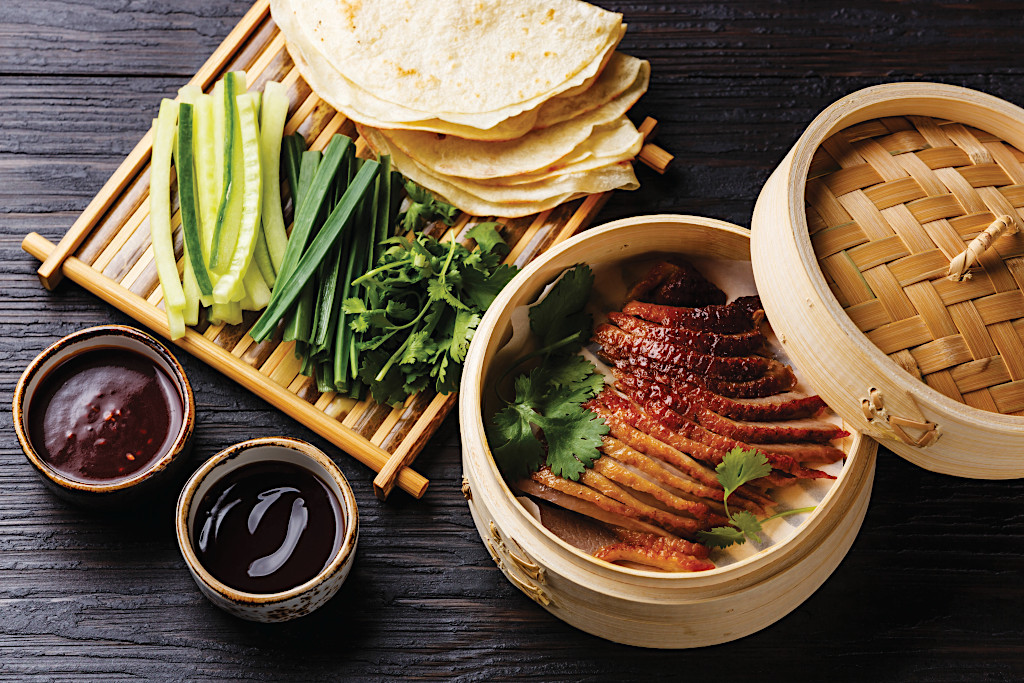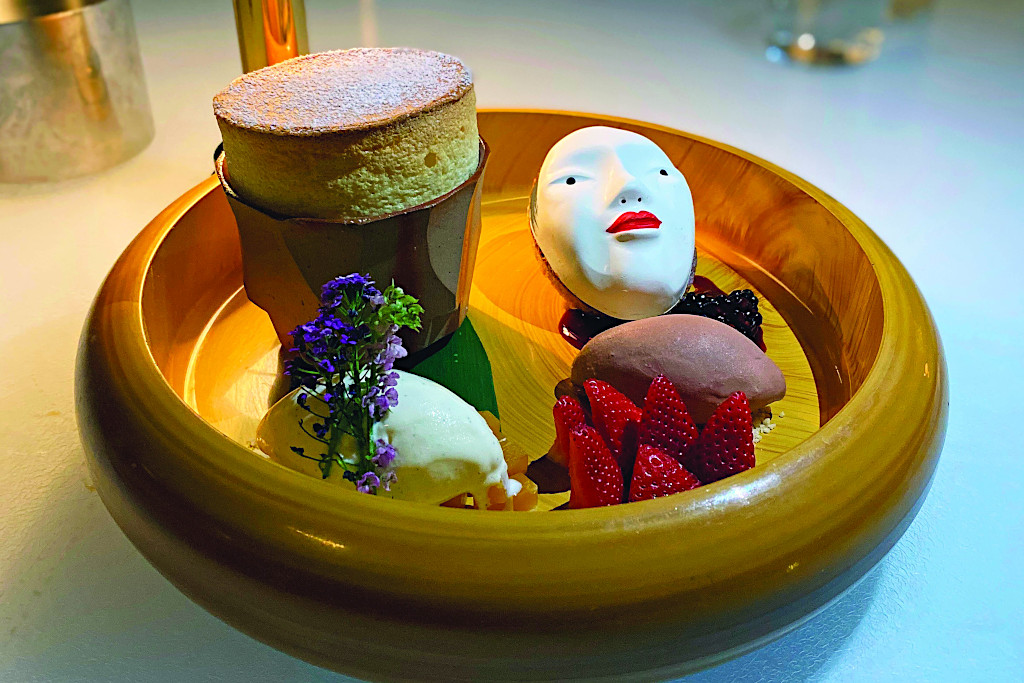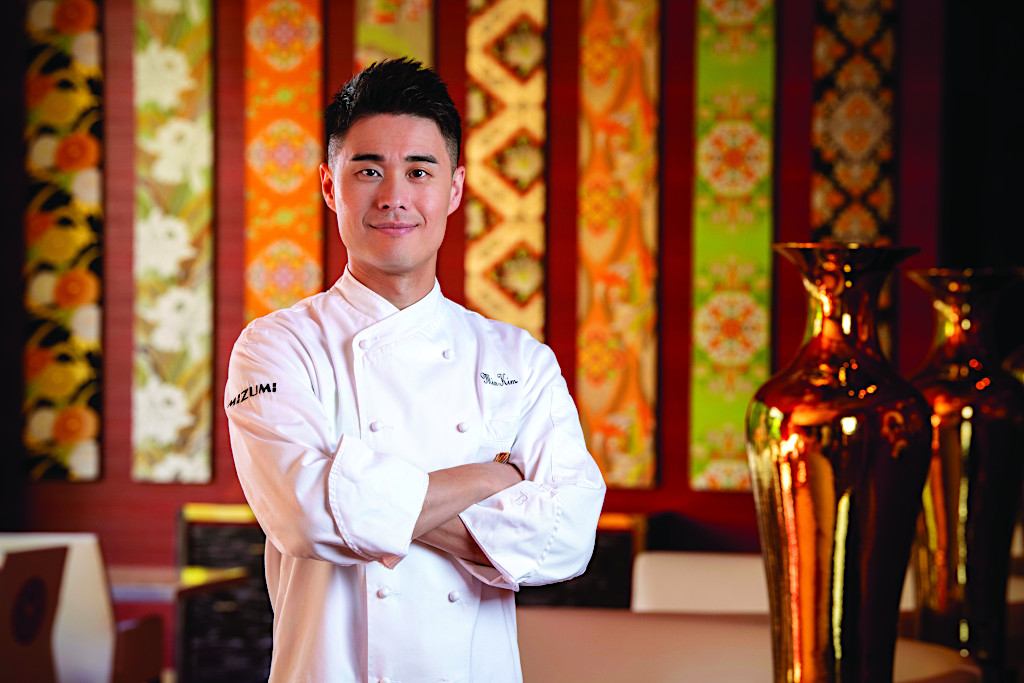Take Mountain View Plaza for example, where you can crawl from District One to Mongolian-inspired Chubby Cattle, serving hot-pot goodies conveyor belt-style; Chinese cornerstones China Mama and Asian BBQ and Noodle; and across the street, popular Fuku Burger for a gourmet Japanese spin Jan-Ie Low on the hamburger.
Chinatown-wide benders could include dim sum and barbecue at bustling New Asian BBQ Tan Tung Ky; endorphin-firing Sichuan dishes at Chengdu Taste; iced coffees, baked goods and more at Korean-inspired Gäbi Coffee & Bakery; and omakase and Wagyu beef served omotenashi-style at high-end Yui Edomae Sushi.
Tellingly, Chinatown is an after-hours magnet for Strip chefs. Industry favorites include Raku from Tokyo-born Mitsuo Endo. His tiny Japanese street-food-inspired “Aburiya Raku” (Charcoal Grill House Enjoyment) is for mouth-watering proteins and fish cooked robata-style over a binchotan grill. Go with the amazingly affordable a la carte menu, splurge on the omakase options, and choose from 65-plus sakes. The feast extends to adjacent dessert-driven Sweets Raku and nearby Raku Toridokoro for grilled and raw, sashimi-style chicken. Grilled dori (chicken lung) is reportedly a natural Viagra.

Peking Duck
Photo: Natalia Lisovskaya
Bon Atchawaran’s whimsical LaMoon is a cozy haven for Japanese- Thai fusion fare, while his serial restaurateur brother Bank modernizes Thai street food at stylish Lamaii. Best-sellers include the shrimp cakes with creamy plum and blueberry sauce and the deep-fried crispy duck breast with Panang curry sauce. An award-winning sommelier, Bank concentrates on Rieslings along with French and smaller U.S. producers. Craft beers and inventive cocktails also serve as dance partners for the spicy food.
Lamaii’s neighbors include Robata En from serial chef-restaurateur Ramir DeCastro, and Strip veteran Brian Howard’s rave-reviewed Sparrow + Wolf.
“Enamored with Asian culture since childhood, I’ve eaten in Chinatown since coming to Vegas in 2000,” said Howard, a Detroit native whose wife is Cantonese. “It was important for me to be here.”
Culturally inspired riffs at Howard’s “neighborhood cookery” include Vietnamese Caramelized Pork Ribs, Japanese Milk Bread Honey Toast, and Thai Lime Pie.
“Melding Asian, Mediterranean and Latin American flavors, chef Brian epitomizes how Chinatown is evolving a greater global presence while maintaining its Asian identity,” said Contursi, who bundles Sparrow + Wolf and Lamaii with Barcelona-born chef Oscar Amador Edo’s avantgarde EDO Tapas on his self-guided “Finger Licking” Chinatown tours.
We nightcapped our whirlwind day at The Golden Tiki. The brainchild of Branden Powers, a pioneering rave promotor who fell into tiki culture at San Diego’s former Hanalei Hotel, this “adult Disneyland” is filled with eye candy including shrunken celebrity heads, Hunter S. Thompson’s knife, and pornographic peepholes. Libations including The Painkiller, pineapple Dole Whip, and flaming tiki drinks fuel the outer orbit fun.
ASIAN DINING AT WYNN LAS VEGAS
Roger Thomas, Wynn Hotels and Resorts’ mastermind designer emeritus, transformed the Vegas experience with his “evocatecture” or architecture that “evokes wonderful moments in people’s lives.” When it came to restaurants, as he once told Elle Décor, “I am hoping for the atmosphere that will spark conversation, and perhaps romance.”Epitomizing stages with menus to match include an Asian quartet at Wynn Las Vegas and sibling Encore, which I experienced over two days in the company of Rebecca Kaplan, Wynn Resorts’ senior catering sales manager. For Encore’s casual Wazuzu, named after a mythic tale of nine Chinese dragons, Thomas created a 27-foot dragon made from 90,000 Swarovski crystals and 2,400 flickering lights. Red and black lacquer elements and antique Asian textiles also set the scene for pan-Asian offerings including Hamachi Chili Sashimi (yellowtail with serrano pepper and yuzu caviar), Cha Siu Bao (steamed buns stuffed with BBQ pork), and the rave-reviewed Drunken Noodles. In 2008, Wing Lei became the first Michelin-starred Chinese restaurant in North America. While Michelin no longer rates Vegas restaurants, Wing Lei remains a star performer. Executive Chef Xian Ming Yu, who opened the restaurant as an assistant chef in 2005 before taking over in 2010, has earned Forbes Five-Star recognition every year since 2017. Thomas’ Ming Dynasty-inspired “frog beam” arches frame the palatial room, with gold, white and jade-green hues creating his intended Chinese jewel box effect. Floor-to-ceiling windows frame the tranquil outdoor garden, which features a gold dragon surrounded by century-plus-old pomegranate trees. Steve Wynn imported the latter from China, where they represent long-life and happiness.I found lasting joy in the pomegranate martini and the ensuing Far East-inspired journey of rich aromas and flavors. From the Peking Duck salad with truffle peanut vinaigrette, on the menu since day one, to the Truffle Soup Dumpling and Alaskan King Crab with prized Osetra (sturgeon) Caviar, it’s a bucket-list culinary expedition.Kaplan, born in the Philippines and raised in Hawaii, came to Vegas in 1999 to join the opening team for the Four Seasons Hotel Las Vegas inside Mandalay Bay. There, she worked with my sister Christiana, who introduced us. Joining Wynn in 2006, she spoke of how Wynn’s culinary program spans Asia and beyond.

WYNN Mizumi Chocolate Mask
Photo: Jeff Heilman
“Our menus, in part, reflect Asian cultural curiosity with food,” she said. “Wazuzu, for example, fuses Chinese, Japanese and Thai cuisines, while Wing Lei is inspired by Cantonese, Shanghai and Szechuan flavors. In consultation with our culinary team, we have created Korean, Indian and other international menus for events. Representing nations around the world, our chefs constantly collaborate and share ideas.”
Her adopted homeland is known as the “Ninth Island” in Vegas. Famously stemming from the success of a mid- ’70’s visitor marketing campaign by Downtown’s California Hotel and Casino (The Cal), Vegas is a tourism magnet for Hawaiians and has the largest Hawaiian population outside of Hawaii. “Count Hawaiian restaurants in the Vegas mix, too,” said Kaplan.
Day two started with lunch at Red 8, named after the signifying Asian color of strength and good fortune. East meets West is the decor, with red crocodile walls and lacquered black millwork giving the early 20th-century European bistro-inspired room its Asian ambiance. Centered on Cantonese noodle dishes and Hong Kong-style BBQ, the menu crisscrosses Asia, from China to Thailand to Vietnam to Korea.
We made quick work of the Deep-fried Crab Claw dim sum, Minced Chicken Lettuce Wrap, Truffle Sauce Roasted Duck, and dumplings variously filled with earthy truffles, ginger-rich soup, and the tri-color trio of beet, jade, and lotus.
Steve Wynn wanted to name Wynn Las Vegas after Picasso’s 1932 painting “Le Reve,” or “The Dream.” Such was the reverie inspired by our grand finale at Mizumi.
Meaning “lake” in Japanese, Mizumi is a world apart. For the main room and side teppanyaki room, Thomas used crimson and gold accents to create a contemporary urban vibe. Complementary bows to the past include classical Noh theater masks, embroidered obi sashes, and hand-painted fans. Transporting, too, is the outdoor Japanese garden.
Backed by a towering, verdant rock wall and cascading 96- foot waterfall, the garden surrounds a koi-filled lagoon with a dream dining spot. Docked at the end of a wooden pier, the Floating Pagoda Table was our seat for the first-class hop to Japan piloted by executive chef Min Kim.
Coming to Vegas from Mizumi at Wynn Palace in Macau, Kim’s flight plan started with the artfully plated Wild Snapper Sashimi Usuzukuri and Bluefin Tuna Tataki before cruising into the Wagyu Gyoza Dumpling, filled with both Kobe beef and rare Hokkaido snow beef; sweet miso-glazed toothfish; and binchotan- grilled Japanese Kobe Beef. For dessert, the Yuzu & Passionfruit Souffle and chocolate medley with the edible Kabuki mask provided the smoothest of landings.
With Wynn Las Vegas beckoning in the distance, it was off to the starry Asian dining galaxy of the Strip.
Asian customers factor significantly in the Vegas equation, and the growing American appetite for gourmet Asian cuisine is also reshaping the market.


